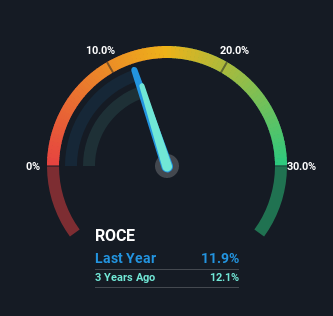Capital Allocation Trends At Sandesh (NSE:SANDESH) Aren't Ideal
What trends should we look for it we want to identify stocks that can multiply in value over the long term? Firstly, we'd want to identify a growing return on capital employed (ROCE) and then alongside that, an ever-increasing base of capital employed. Ultimately, this demonstrates that it's a business that is reinvesting profits at increasing rates of return. In light of that, when we looked at Sandesh (NSE:SANDESH) and its ROCE trend, we weren't exactly thrilled.
Return On Capital Employed (ROCE): What Is It?
If you haven't worked with ROCE before, it measures the 'return' (pre-tax profit) a company generates from capital employed in its business. To calculate this metric for Sandesh, this is the formula:
Return on Capital Employed = Earnings Before Interest and Tax (EBIT) ÷ (Total Assets - Current Liabilities)
0.12 = ₹1.2b ÷ (₹11b - ₹538m) (Based on the trailing twelve months to September 2022).
So, Sandesh has an ROCE of 12%. That's a pretty standard return and it's in line with the industry average of 12%.
View our latest analysis for Sandesh

Historical performance is a great place to start when researching a stock so above you can see the gauge for Sandesh's ROCE against it's prior returns. If you'd like to look at how Sandesh has performed in the past in other metrics, you can view this free graph of past earnings, revenue and cash flow.
What Can We Tell From Sandesh's ROCE Trend?
On the surface, the trend of ROCE at Sandesh doesn't inspire confidence. To be more specific, ROCE has fallen from 19% over the last five years. Although, given both revenue and the amount of assets employed in the business have increased, it could suggest the company is investing in growth, and the extra capital has led to a short-term reduction in ROCE. If these investments prove successful, this can bode very well for long term stock performance.
In Conclusion...
In summary, despite lower returns in the short term, we're encouraged to see that Sandesh is reinvesting for growth and has higher sales as a result. And there could be an opportunity here if other metrics look good too, because the stock has declined 44% in the last five years. As a result, we'd recommend researching this stock further to uncover what other fundamentals of the business can show us.
Like most companies, Sandesh does come with some risks, and we've found 2 warning signs that you should be aware of.
While Sandesh isn't earning the highest return, check out this free list of companies that are earning high returns on equity with solid balance sheets.
New: Manage All Your Stock Portfolios in One Place
We've created the ultimate portfolio companion for stock investors, and it's free.
• Connect an unlimited number of Portfolios and see your total in one currency
• Be alerted to new Warning Signs or Risks via email or mobile
• Track the Fair Value of your stocks
Have feedback on this article? Concerned about the content? Get in touch with us directly. Alternatively, email editorial-team (at) simplywallst.com.
This article by Simply Wall St is general in nature. We provide commentary based on historical data and analyst forecasts only using an unbiased methodology and our articles are not intended to be financial advice. It does not constitute a recommendation to buy or sell any stock, and does not take account of your objectives, or your financial situation. We aim to bring you long-term focused analysis driven by fundamental data. Note that our analysis may not factor in the latest price-sensitive company announcements or qualitative material. Simply Wall St has no position in any stocks mentioned.
About NSEI:SANDESH
Sandesh
Together with its subsidiary, Sandesh Digital Private Limited, engages in the editing, printing, and publishing of newspapers and periodicals in India.
Flawless balance sheet established dividend payer.
Similar Companies
Market Insights
Community Narratives



